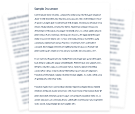Deed of Indemnity (General)
This Deed may be used to secure an indemnity from one party to another- that is, an obligation to remunerate the other party for any loss or damage incurred as a result of a particular event.
4.5 (2 reviews)
Last updated January 14, 2025
Under 5 minutes
Suitable for Australia
Written by Edwin Montoya Zorrilla
Reviewed by Damin Murdock
Document Overview
An indemnity is a promise by one party (the indemnifier) to take on the obligation of any loss or damage that may be incurred by another party (the indemnified party), usually as a result of entering into a transaction with the indemnified party. For example, many building contracts between the owner of property and the builder contain clauses where the builder indemnifies the owner for any third-party claims brought against the owner for damage or injury caused by the builder’s employees or sub-contractors. An indemnity can also be effected as a separate document, as is done in this deed.
In Australia, certain legislation, regulations and industry codes may affect the enforcement of an indemnity where the indemnity does not comply with the relevant legislation, regulations or codes. It is important when drafting indemnities to be aware of the relevant legislation and codes which may impact the interpretation and enforcement of the indemnities. , such as the Australian Banking Association (ABA) Banking Code of Practice and the National Credit Code.
What does the Deed of Indemnity (General) cover?
- The parties' continuing obligations;
- The event(s) that will trigger the indemnity;
- Procedures for notificationa and payment; and
- Standard provisions including dispute resolution.
The Legal Risk Score of a Deed of Indemnity (General) Template
Our legal team have marked this document as medium risk considering:
- The guarantor is required to cover all payments and obligations of the company if it fails to meet its commitments, which could lead to significant financial liability.
- The lender has the authority to obtain and exchange information about the guarantor’s personal and commercial credit, potentially affecting the guarantor's privacy and credit status.
- The deed has specific signature requirements.

Deed of Indemnity (General) Checklist
Complete your free Deed of Indemnity (General) with our checklist
Ensure Proper Execution
Make sure that the deed is properly signed by both parties as indicated in the execution clause to legally bind the agreement.
Update Contact Information
Verify and update the addresses and email addresses for both parties as specified in the document to ensure all future communications and notices are correctly directed.
Monitor Compliance
Regularly check that all obligations under the deed, especially regarding payments and indemnity claims, are being met to avoid any breaches of the agreement.
View Sample Deed of Indemnity (General)
It's never been so easy
Sign-up to a free Lawpath account
Get started and we'll take care of you. It's that easy.
Browse our 500+ legal documents
Browse our 500+ legal documents to find the perfect match to cover your business needs. We've got Compliance, Employment, Service agreements and more.
Collaborate with e-Sign and Sharing
Having access to your legal documents has never been easier. You can request e-signature, share the document and download for an efficient collaboration.
Create unlimited legal documents and eSignatures for only $39/month.
Upgrade to a Lawpath legal plan to boost your new business.


Here's what people say about Lawpath's Deed of Indemnity (General)
Reviews are managed by BazaarVoice and comply with the BazaarVoice Authenticity Policy. Reviews are independently verified by BazaarVoice and detail our customers' real experiences.
0 reviews
Most Recent
Highest to Lowest Rating
Lowest to Highest Rating

